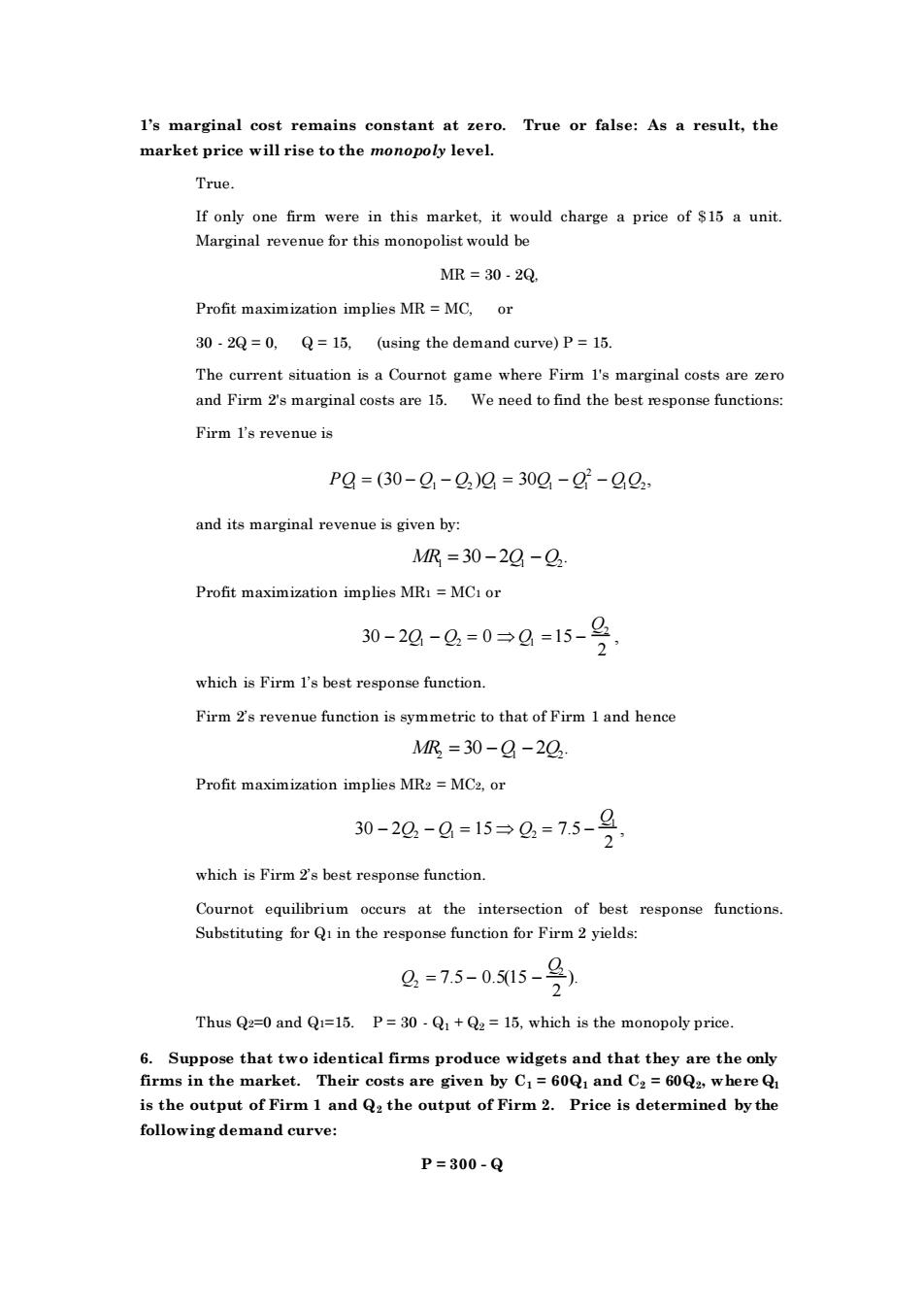正在加载图片...

I's marginal cost remains constant at zero.True or false:As a result.the market price will rise to the monopoly level. True If only one firm were in this market,it would charge a price of $15 a unit Marginal revenue for this monopolist would be MR=30-2Q Profit maximization implies MR =MC,or 30-2Q=0,Q=15,(using the demand curve)P=15. The current situation is a Cournot game where Firm I's marginal costs are zero and Firm 2's marginal costs are 15.We need to find the best response functions: Firm I's revenue is PO=(30-0-0)0=300-0-20 and its marginal revenue is given by: MR=30-2g-Q Profit maximization implies MR=MCior 30-2g-0=0→g=15-g which is Firm I's best response function. Firm 2s revenue function is symmetric to that of Firm 1and hence MR=30-g-2g Profit maximization implies MR2=MC2,or 30-20-g=15-0=75-g 2 which is Firm 2's best response function. Cournot equilibrium occurs at the intersection of best response functions. Substituting for Qi in the response function for Firm 2 yields: 0=75-005-号 Thus Q2=0 and Q=15.P=30-Q+Q2=15,which is the monopoly price. ose that two identical firm ket.Their costs d C. is the output of Firm 1 and Qa the output of Firm 2.Price is determined by the following demand curve: P=300-Q1’s marginal cost remains constant at zero. True or false: As a result, the market price will rise to the monopoly level. True. If only one firm were in this market, it would charge a price of $15 a unit. Marginal revenue for this monopolist would be MR = 30 - 2Q, Profit maximization implies MR = MC, or 30 - 2Q = 0, Q = 15, (using the demand curve) P = 15. The current situation is a Cournot game where Firm 1's marginal costs are zero and Firm 2's marginal costs are 15. We need to find the best response functions: Firm 1’s revenue is P Q1 = (30 − Q1 − Q2 )Q1 = 30Q1 − Q1 2 − Q1Q2 , and its marginal revenue is given by: MR1 = 30 − 2Q1 − Q2 . Profit maximization implies MR1 = MC1 or 30 − 2Q1 − Q2 = 0 Q1 =15 − Q2 2 , which is Firm 1’s best response function. Firm 2’s revenue function is symmetric to that of Firm 1 and hence MR2 = 30 −Q1 − 2Q2 . Profit maximization implies MR2 = MC2, or 30 − 2Q2 − Q1 = 15 Q2 = 7.5 − Q1 2 , which is Firm 2’s best response function. Cournot equilibrium occurs at the intersection of best response functions. Substituting for Q1 in the response function for Firm 2 yields: Q2 = 7.5 − 0.5(15 − Q2 2 ). Thus Q2=0 and Q1=15. P = 30 - Q1 + Q2 = 15, which is the monopoly price. 6. Suppose that two identical firms produce widgets and that they are the only firms in the market. Their costs are given by C1 = 60Q1 and C2 = 60Q2 , where Q1 is the output of Firm 1 and Q2 the output of Firm 2. Price is determined by the following demand curve: P = 300 - Q